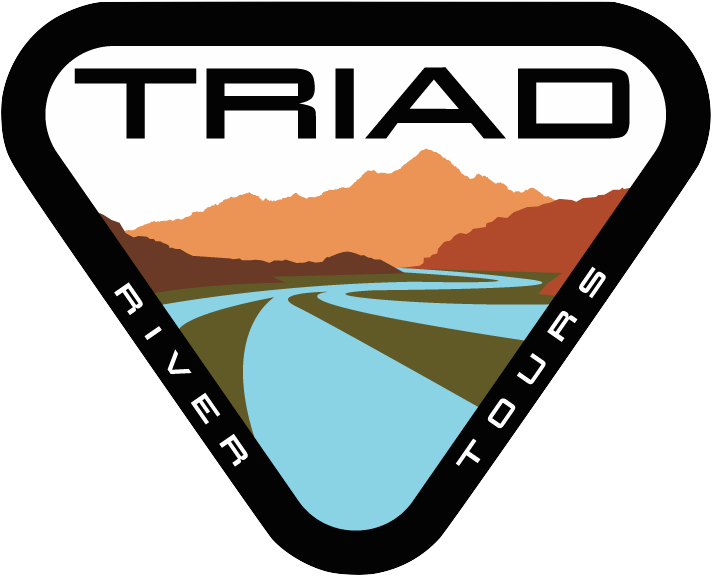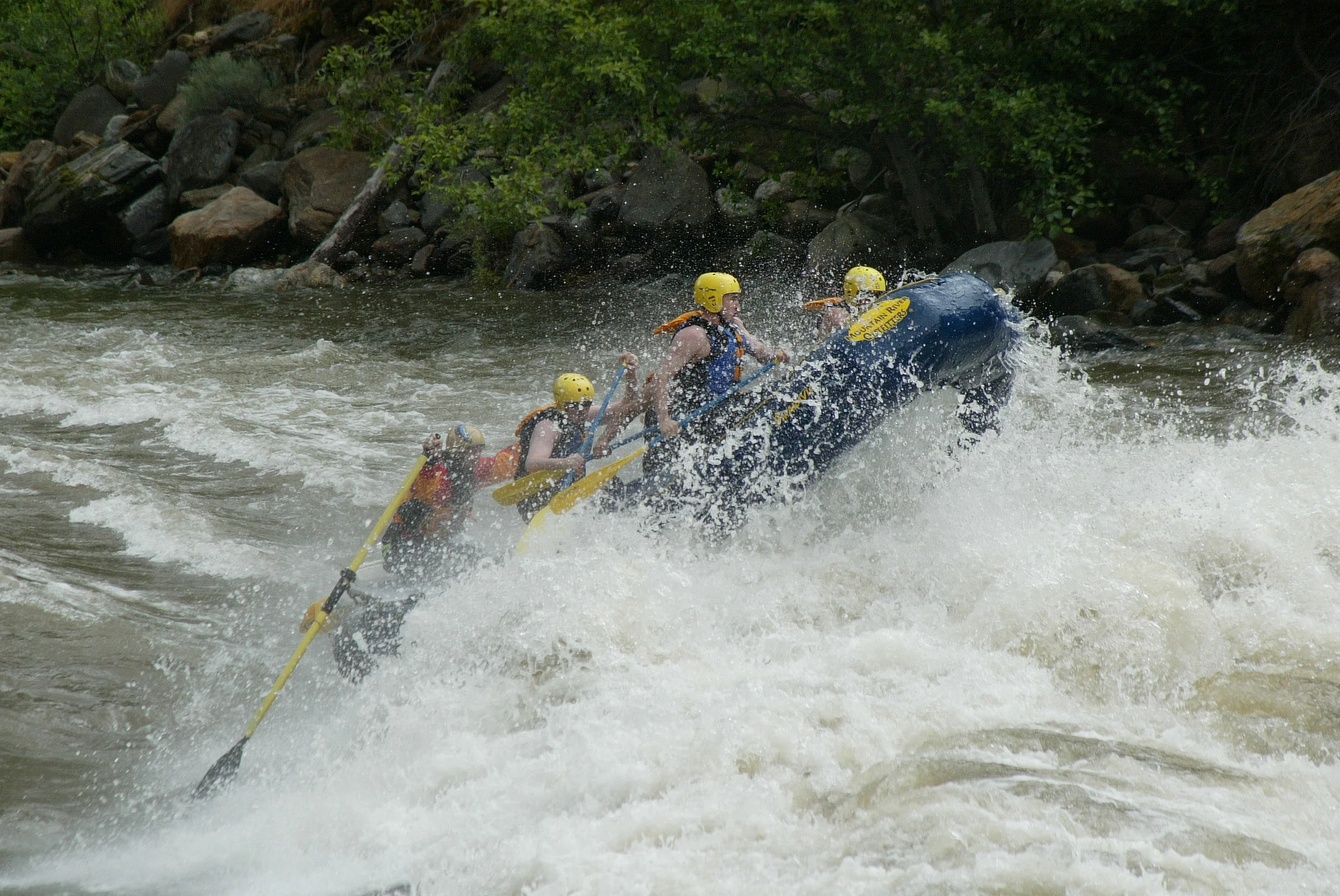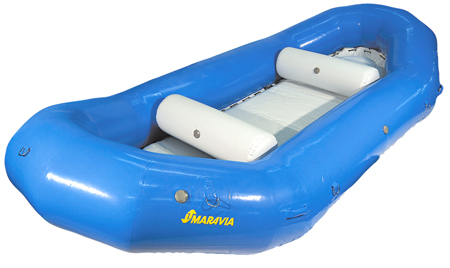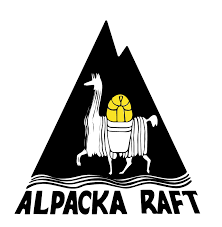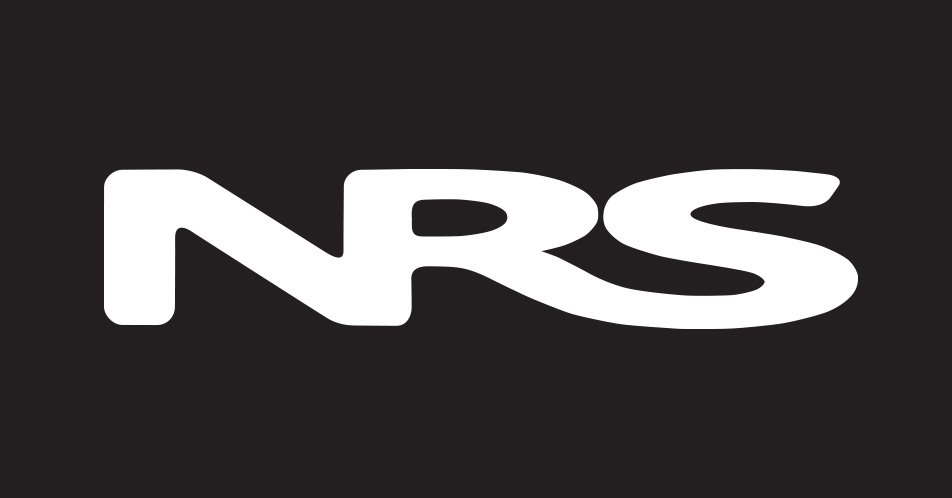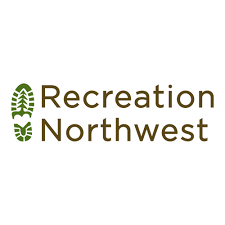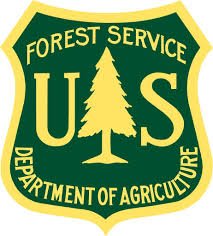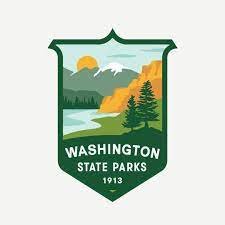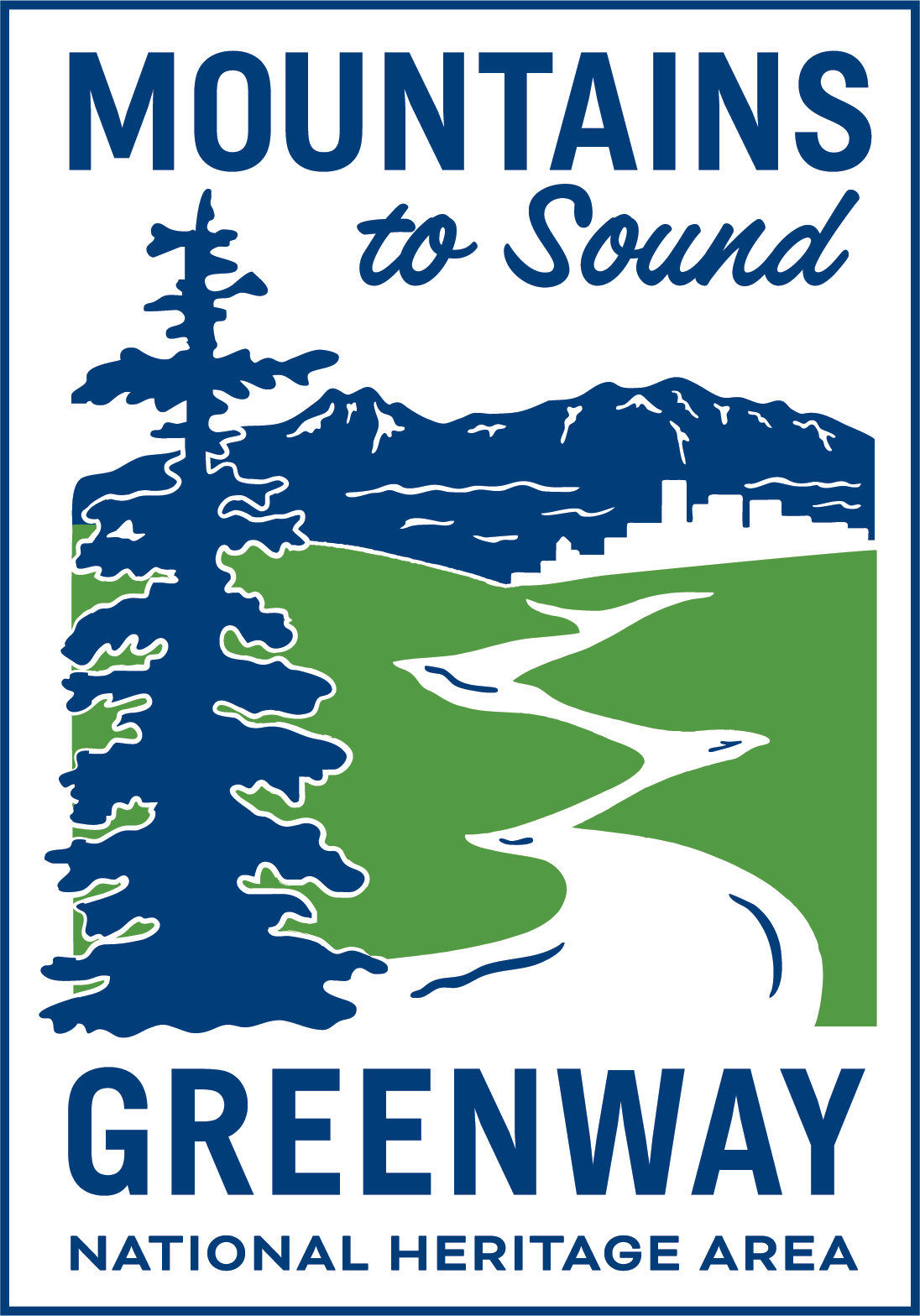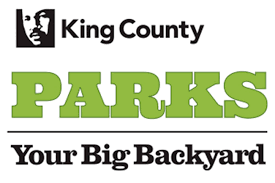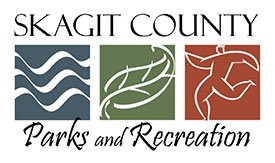Large rivers and commercial whitewater rafting operations where systems are designed to carry 8 passengers need a raft 15 foot or longer, with a width of at least 6’6. These raft designs are not as common in the private rafter market, but for commercial rafting companies, carrying 8 guests is far more profitable than 6 or 4, and as a result, this is a raft category that gets a lot of attention from the big rafting companies. Historically, this category is dominated by a few raft manufacturers in the USA; Maravia, NRS, and Hyside. In Washington the Aire 156 is popular, and Aire’s designs are become more and more popular over time in all areas, and Aire’s larger rafts are very popular in the private rafter market as they are less prone to flipping in some situations.
While there are many 16-foot designs we have used, we are going to limit this list to the few that we have seen used successfully in larger fleets for commercial rafting operations. That is to say, this list is focused on the commercial rafting company using these boats as 8 passenger paddle rafts, or as multi-day rafts carrying people and gear. We have notably no experience with the Hyside or Sotar models, and that is regrettable because it’s almost certain that both manufacturers have large raft designs that would rival the ones that we have used, but like our other comparisons we are going to stick with rafts that we have extensive personal experience with.
It is important to note that we have bunched up the 15 and 16 foot rafts into one comparison, and that’s going to create some issues. The reason we did that is that in our operation, and use on the Whitewater Rivers of Western Washington, we use both raft lengths for the same purposes. As always, the most important consideration for us is use of the rafts in our specific commercial operation. We try to speak from direct experience, and inferring quality of rafts in other situations isn’t really something we’re qualified to do. This is essentially a recreation of the internal feedback we have received from our guides staff on the rafts mentioned, as they apply to our system at Triad River Tours. We will update the comparison as we have tested more rafts.
1. Maravia Williwaw 1.5/Cyclone
2. NRS E-150
3. NRS E-160
4. Avon 16’
5. Aire 156R
6. Riken Nez Perce (mfg. by NRS)
7. Maravia Williwaw 2
8. Maravia Mistral
9. Aire 156D
10. NRS E-151
11. NRS E-161
NRS E-161
The NRS E-161 whitewater raft. Source: https://www.nrs.com/product/1089/nrs-e-161-self-bailing-rafts
The E-161 is a favorite among the NRS staff and is used commercially by outfitters on difficult whitewater rivers like the Lochsa in Idaho. The design seems to work well with a paddle crew, and the long, protruding shovel like front end helps the raft recover after steep drops. The 20-inch tube diameter helps paddlers reach the river without leaning over, and thus, in theory, helps the raft go faster. The raft is exceptionally stable as it isn’t unnecessarily narrow like a lot of paddle-centric designs are. The E-161, on paper, appears to be perfect for our operation, and that’s why we bought one. The feedback from the guides was that the E-161 was simply too large for the NRS material to retain rigidity; guides complained that it would be in “two holes at once, responding differently to both of them”. The NRS rafts lack rigidity unavoidably by design, making the more forgiving in most situations, but for experienced professional guides who like control, the E-161 raft design simply had a mind of it’s own a little too often. We did not try the E-161 with a center-mount, and the design seems to beg you to run a paddle crew down big water. It’s a niche raft, and has lines that resemble the old Riken Nez Perce. We would like to see one of these rafts with slightly larger tubes and about 4 inches shorter (see the E-151 raft review below).
Best thing about it: Sporty, Sporty, And Sporty
Worst thing about it: Floppy, Floppy, And Floppy
NRS E-151
The prototype NRS E-151 whitewater raft. Source: Triad River Tours guide iPhone
The E-151 raft design was designed by NRS specifically for larger rivers with paddle crews that had to navigate through somewhat technical boulder gardens; essentially, this raft was designed for the same river conditions that we encounter on the Skykomish River and the Sauk and Snoqualmie Rivers in high river conditions. The E-151 is not, to our knowledge, available to the public, but it’s worth thinking about as the design is similar to several models used commercially on rivers like the Gauley and American Rivers.
The E-151 is immediately and distinctly recognizable from other NRS designs because it has rapidly (pun intended) upswept bow and stern shapes protruding from large main tubes. The E-151 looks, on land, like the whitewater raft equivalent of a GSXR motorcycle; it looks fast just sitting there. The top of the raft that we demoed had a strip of material designed to provide added rigidity. Ian at NRS noted that this was a feature they are looking to add to more rafts, and after running the E-151 with the stabilizing strip and the E-161 without it, we really think he is on to something. NRS rafts are floppy due to the flex inherent in the Pennell Orca material; this isn’t inherently a bad trait to have with whitewater rafts, particularly those being used in challenging whitewater by less experienced guides (as is the norm in nearly all corners of the whitewater rafting industry), but experienced guides that have spent time in rigid boats routinely complain of the characteristically hyper-mobility and flex of the NRS rafts.
The E-151 is in a word, eccentric. It does not do well with a standard stern mount design first of all because there is a gap created by the frame bars that is just wide enough to fit a human arm (and therefore snap it), and the guide sits so close to the river that they have somewhat poorer than average visibility, and the oar position is as it is with most diminishing tubed rafts, in that the oars are simply awkwardly positioned right in front of the lower rib cage, making the guide prone to injury. NRS has insisted that a change in frame design could remedy these issues, and they’re probably right, but we are going to move forward with the data that we have.
The E-151 is reminiscent of a famous Wing design that was used on the Gauley for decades commercially. It handles steep drops with literal ease, and the raft seems to glide through class 4-5 whitewater like it’s floating on air. The E-151 has a grace to it that’s hard to quantify, but it definitely rides smoothly. The drawbacks to the design were that despite the large main tubes (we estimate these to have been 22 inches in diameter) the raft has a small enough footprint to make it a liability in low technical river conditions with 8 paddlers. Additionally, the design and intended use in our system created a “guide-a-pult” situation many times, where the guide would navigate to run a hole and after clearing it the stern would snap back causing the guide to levitate like an enlightened yoga master, but much less gracefully come smashing down on top of their guests. The E-151 is eccentric, but a sexy looking boat that excels at it’s intended purpose; it’s a straight paddle raft designed for big yet semi-technical river conditions like the Gauley. It does well at that kind of thing.
Best thing about it: Fun to paddle, but works best with a team of 6 paddlers in technical whitewater.
Worst thing about it: Sits too low in the water, so in technical rivers of Washington tends to get hung up a lot.
Aire 156D
The Aire 156D whitewater raft. Source: http://www.aire.com/aire-raft/156d.asp
First and foremost, we want to give a shout out to Justin Walsh of Bearpaw River Expeditions who ran these rafts, as well as the similarly shaped Riken Nez Perce, down the Lochsa River with great success for years, and proved that you can go big in whitewater and still be safe as long as you can recover quickly. The Aire 156D design, as a result, is well proven in big water, and is used by Washington commercial whitewater river outfitters as a “people mover” on rivers like the Skagit and Wenatchee, where there is more straightforward whitewater, but the need to carry 8 guests reliably with less skilled guides is prevalent. The 156D is a diminished tube design that pierces waves and holes, rather than ride up and over them. The D design also helps with the wind on multi-day rafting trips by not grabbing the wind. The issue with the design for us is that it simply offered more splash, and in our region, where our river water is usually just a few degrees above freezing in early season (the time when we use larger rafts like this specifically), there is an immediate and unanimous decision to use round tubed raft designs like the 156R. The 156D is a great all around raft for the private rafter, and very few large raft designs can handle the plethora of different conditions than the Aire 156D.
Best thing about it: Big water beast
Worst thing about it: Difficult to maneuver with 8 passengers
Maravia Mistral
Maravia Mistral whitewater raft. Source: http://www.maravia.com/index.php/main/product_detail/160/3
If you have been on Hells Canyon or the Main Salmon rivers in Idaho you have unquestionably seen the Mistral. This raft is a favorite among outfitters there, and like clockwork, is dependable in all conditions common on multi-day whitewater rafting rivers. The Mistral is huge, at 16’3 and 7’6 wide, it is one of the largest rafts that we have utilized at Triad River Tours. It has 22-inch tubes, and thus, is very tall for our paddlers, causing them to have to lean over in order to get good purchase with their paddle blades. The Mistral is well at home as a multi-day center-mount oar rigged raft, and has an impressive ability to carry heavy loads and remain maneuverable. The Mistral, like all Maravia designs, is built to last a lifetime, and on multi-day sections with deeper water, it’s unlikely that a private rafter would ever need to replace one. The biggest issue for us and our intended use for the Mistral is the 22-inch tubes and the high kick in front and rear. While we want to shield our guests from excessive splash, the Mistral literally makes the trip seem too automatic, simple, and mechanical. Our guests don’t feel like they’re rafting because the Mistral simply rides over everything. The Mistral is just a little too big for Western Washington Whitewater in our estimation, and unless someone is looking for a dedicated bit river multi-day rafting design, we think there are better ones on this list for all around rafting in the Cascades.
Best thing about it: Multi-day gear carrying marvel.
Worst thing about it: Big and clumsy like wearing boots a size too big.
Maravia Williwaw 2
The Maravia Williwaw 2 whitewater raft. Source: http://www.maravia.com/index.php/main/product_detail/159/3
The Maravia Williwaw 2 is a half way point between the Williwaw 1.5 and the Mistral, while being more akin to the latter. The Willy 2 has the same 22 inch tubes, and 7’6 width, but uses only 3 stock thwarts, making it unusually designed for 6 paddlers in a nearly 16 foot raft. The Willy 2 is unavoidably a centermount craft, designed for multi-day use and oars. We used it as a stern mount paddle assist raft in high water and it did very well, in fact, better than the Mistral, but for all around use it’s just not suited well for Western Washington Whitewater when compared to the smaller tubed Williwaw 1.5.
Best thing about it: Excellent all around for private rafters in the Pacific Northwest
Worst thing about it: 22 inch tubes are awkward for paddling, and why only 3 thwarts?
Riken Nez Perce (now mfg. by NRS)
The Riken designed NRS E-162D "Nez Perce" whitewater raft. Source: https://www.nrs.com/product/1189/nrs-e-162d-nez-perce-self-bailing-rafts
Anyone who knows their raft design history knows that there was a time when Riken was the industry leader in raft design, and that design ethos was headlined by the multi-day all arounder, the Nez Perce, or the “Nezzie” as many of the guides called it. Hughes, a company that has decades of experience on the Middle Fork Salmon and Hells Canyon (amidst others) has shown the Nez Perce to be useable on a lot of different rivers, and it is still a favorite among seasoned professional guides. The original Nez Perce was flawed in one critical way in that the I beam design of the floor ran crossways in the front, causing unnecessary and excess drag; this wasn’t an overly prevalent design flaw because the rest of the rafts proportions were nearly perfect. The diminishing tubes performed excellently in the wind, the large side tubes carried a frame well, and the front and rear cargo areas made running self contained multi-day whitewater rafting trips easier than ever. 20 years ago the Nez Perce was the standard by which other raft designs in this class were judged, and the design itself was a game changer for the entire rafting industry. The Nez Perce design is now manufactured by NRS, using essentially the same material that was used in the traditional Nezzie. You can still not go wrong with investing in this big water, do-it-all, jack of trades raft design… and you can navigate whitewater rivers in style knowing that you’re rowing or paddling a piece of raft design history.
Best thing about it: You can literally do everything in this raft aside from run small rivers in lower conditions.
Worst thing about it: Is a basic design that has been improved upon since its inception. Is a better straight paddle raft than a stern mount (despite being often used as one).
Aire 156R (Sealed floor model)
Aire 156R whitewater raft. Source: http://www.aire.com/aire-raft/156R.asp
In the never ending search for a high water raft “crusher” at Triad River Tours, a raft that should be able to carry us through the dauntingly cold and challenging whitewater of May and early June, we ended up with a purple Aire 156R with a sealed floor. After the maiden voyage we had to replace a valve, which caused the raft to be removed from the Skykomish fleet for a few weeks; consequently we weren’t able to see this raft perform in it’s intended modality. Instead, by the time our new valve (ours had the archaic D7 valve and thus was a special order and not on our shelves at the shop) arrived and was installed, the raft was commissioned to join the Sauk fleet in fairly moderate river levels. We realize that this is unfair to the design, as it’s larger than the 156D, and thus we can expect similar results in high water, but because we don’t have data in high water, we are hesitant to infer the raft designs performance in big whitewater situations.
What we can tell you is that with an Aire raft, if you want to go with a larger raft, we recommend paying a little extra for the sealed floor. The Aire design with the ballast floor makes larger rafts with 8 loads lethargic, and while the rafts are marketed as having excellent “tracking”, we would argue that the word tracking could be replaced with “inertia”, meaning that you cannot turn the things once they are headed in one direction. The 156R raft with a sealed floor that we had was sportier than a non-sealed floor 156D, and thus, between the two, is our preference. This raft is very similar in performance to our beloved Maravia Williwaw 1.5, and had we been able to operate this raft design in larger whitewater, it’s possible that it would have unseated it as our fleet raft. We will put in another call to Aire to see if we can get “Barney” back up to Western Washington. For now we’ll keep this raft near the middle, and without a full data set we’ll just say that early feedback for this raft design was favorable.
Best thing about it: Handles great.
Worst thing about it: We never were able to test it in high water Class 4-5 whitewater conditions.
Avon 16’
NO picture. No longer manufactured. :)
While Avon no longer occupies the dominant position as market leader in whitewater raft manufacturing that it once did (having turned more to the salt water and open ocean market), the old Avon rafts are still very acceptable as large capacity rafts, and because they were made of such a durable material, there are many of these old rafts available in the used raft market. Many rafting companies from the 1980s and 1990s based their entire fleet on the Avon design, and as they upgraded to more modern rafts, these rafts went on sale, and you can thus find hundreds of these old relics rolled up in garages and basements of private river rafters across the USA. The Avon rafts were impressively light, and had amazing durability, while being fairly easy to patch; this is what made the Avon whitewater rafts so desirable for whitewater river outfitters back in the old days. But since the heyday of Avon, times have changed and the material is neither as light or durable than the urethane used by Sotar, and the design is no longer superior to any other standard round boat design. Still, one the busy weekends on rivers like the Gauley, Arkansas, or American, you will see these rafts being inflated for their customary token once per year runs, to be cleaned, obligatorily coated with Formula 303, and again rolled to await their next use a year later. The Avon rafts are a good purchase if you can find a used one for fewer than 2 grand, and such bargains are not completely uncommon if you peruse Craigslist or EBay long enough. It’s hard to go wrong with an old Avon.
Best thing about it: Good rafts that can be found at a bargain price.
Worst thing about it: You will have a hard time getting the outline of the previous outfitters logos off of the side of it.
NRS E-160
The NRS E-160 whitewater raft. Source: https://www.nrs.com/product/1095/nrs-e-160-self-bailing-rafts
The NRS E-160 would have to be considered the modern industry standard for all around 16 foot rafts. More desirable as a multi-day expedition gear hauler than a straight paddle raft due to the large diameter (22”) tubes, the E-160 has a formidable footprint on the river, and runs big water predictably while instilling confidence in less experienced guides. The E-160 is rock solid in every way and is a safe bet for any commercial operation, which is why you see fleets of E-160s from multi-day outfitting companies in Idaho and Oregon, to large commercial paddling fleets on the Gauley and New in West Virginia. The design is flawless and imminently standard, and the raft tracks well while carrying beautiful ferry lines across currents with efficiency that’s rare for a raft its size.
The E-160’s detriment in our operation is that the 22-inch tubes create difficulties for our paddlers who are equipped with 57-inch paddles. We use one length paddle for our 13-foot rafts all the way to our large 16-foot rafts, and thus, while this is a little nit picky, the E-160 isn’t viable for us as a high water whitewater “crusher”, and we prefer the E-161 to it for that specific task. For all around use, however, the E-160 is a better bet for most private rafters and commercial whitewater operations.
Best thing about it: Dominant big whitewater river “crusher” and excellent multi-day gear carrier.
Worst thing about it: 22 inch tubes make it obsolete as a paddle raft in Western Washington, and the size of this thing just looks awkward on our little coastal rivers.
NRS E-150
The NRS E-150 whitewater raft. Source: https://www.nrs.com/product/1088/nrs-e-150-self-bailing-rafts
Strangely enough the highly versatile E-150 is second on our list because it gives a western Washington river rafter the ability to run low water trips in technical conditions as well as tackle early season gaping holes and waves. The one issue that it has is that loaded down with 8 passengers (we have one that has thwart attachments for 3 or 4 thwart configurations) it becomes a missile that cannot be steered away from trouble. Like the scud missiles of Saddam Hussein in the OG Gulf War, the E-150 does not know where it’s going when there are 8 paddlers at the helm, and this is usually taking place on the Skykomish, Snoqualmie, or Sauk Rivers in May or June for us, when we really need the raft to react to guide decisions. The rudderless E-150 is best suited in these cases as a 6 load raft, and while that’s not preferable, it does exceptionally well with a stern mount oar rig, coupled with 6 paddlers in high water situations. While this isn’t as profitable of a configuration for a commercial whitewater rafting operation, it also gives us the added advantage of only having 6 swimmers in case of a flip (barring a superhuman dry flip, of course). The E-150 would be our choice for our fleet raft if we were not so in love with the Maravia Williwaw 1.5. It is important to note that between the two rafts, either can be special ordered with 3, 4, or 5 thwart attachments (with 5 thwart attachments the raft can be operated with symmetrical 3 and 4 thwart configurations). The E-150 and the Williwaw 1.5 are identical in every way other than tube diameter, with the Willy coming in at 21-inch diameter tubes and the E-150 with 20-inch tubes. The stock E-150 comes with 3 thwart attachments and the Willy 1.5 with 4. A 15 foot raft with only 3 thwarts isn’t viable for most commercial operations, and thus in a stock configuration the Williwaw 1.5 wins out for reasons of profitability. Still, the NRS rafts roll easier, and are about 20% cheaper. Additionally, the E-150s fantastic design traits can be had by the private boater by purchasing the Otter 150. At a retail price point of around $5,000 the Otter 150 offers tremendous versatility to a private boater, being lighter than the E-150 or the Williwaw 1.5, and being a little suppler and less durable. This is a mainstay design that is one that can accomplish a lot for a western Washington whitewater river rafter.
Best thing about it: Most versatile raft we’ve tested, and comes at a gentler price tag than the Williwaw 1.5 while having almost exactly the same performance characteristics.
Worst thing about it: Is almost as good as the Williwaw 1.5 but lacks the ability to carry 8 passengers in high water river conditions.
Maravia Williwaw 1.5
The Maravia Williwaw 1.5 whitewater raft. Source: http://www.maravia.com/index.php/main/product_detail/157/3
The Williwaw 1.5 is perhaps more popular in Idaho than anywhere else, where it can be seen carrying guests down anything from the Cabarton section of the Payette River to the large rapids of Hells Canyon, and everything in between. It tends to be overlooked as a “tweaner” design that neither excels at big water gear carrying nor as an 8 passenger paddle raft, but because we are a commercial rafting operation focusing on the tight, technical rivers of Western Washington, and because in higher water we are not opposed to running rafts with only 6 passengers, the Williwaw 1.5 occupies a serious sweet spot for us, and to put it simply; we love this thing. If you see a Triad River Tours trip, you’ll most often see us in these boats, in red, with our big blue and black logos up front. The rafts are durable, rigid, perform excellently, and work well in Class 3 whitewater like the Sauk, even with loads of 8 paddlers.
The Williwaw 1.5 is a tight fit for 8 passengers, and thus when used in higher water can get a little out of control due to inertia. If the Williwaw 1.5 could be made 6 inches longer, you would have a superb high water machine for the coastal rivers of Washington like the Snoqualmie, Skykomish, and Sauk Rivers. The rigid design make the Williwaw 1.5 perfectly capable of short waterfalls like Husum Falls, and in the case of multi-day traveling, it does very well with a center mount frame and 9.5 foot oars (we use shorter oars on more technical rivers, and longer oars on flatter, less technical rivers due to the potential for snagging).
The Maravia Cyclone is very simply the exact same raft as the Williwaw 1.5 but with diminishing tubes in the bow; this design functions specifically as a stern mount paddle assist raft on rivers where 6-8 passengers are being carried as a paddle team, and some extra splash is desired. Additionally, for center-mounted tasks, the Cyclone provides the exact same handling characteristics of the Willy 1.5, but has the added benefit of additional cargo capacity in the front, while being a hair lighter, and having added visibility looking downstream. However, it may be important to note that the added splash of the Cyclone isn’t typically desired in the frigid waters of the Cascades, which puts our guests in even more hypothermia risk, and the Cyclone will not have the big water capabilities of the Williwaw 1.5 in situations where there are steep drops as the diminished front end on the Cyclone is quite low and has a tendency to “spear” into the waves, providing a fun splash and an adrenaline rush in Class 3 water, but on rapids like Boulder Drop of the Skykomish can cause the raft to literally “endo” by spearing underneath the foam pile after the infamous drop of the “picket fence”. The Williwaw 1.5 is thus our choice for Western Washington whitewater, while being notably similar to the Cyclone raft design in every dimension but one, crucial aspect.
The Williwaw 1.5 has one distinct disadvantage in Western Washington that may come as a surprise to many, and that is that the geology of the Cascade Mountains creates river rocks that are porous and granular; there is a faster wear factor on Maravias on these rivers that we have noticed. On the proverbial flip side (pun intended), Maravia has excellent warranty service and is a great company as far as relationships, and they stand fully behind their products. The Williwaw 1.5s excel for all around use on coastal rivers, and while they are slightly large on the river in comparison to 14 foot rafts, the Williwaw 1.5 is exceptionally and impressively nimble; this design turns on a dime, and the 21” tubes give it more carrying capacity than the aforementioned E-150. The Williwaw 1.5 is the ultimate all around raft for Washington Whitewater in our opinion, and while it’s at a higher price point than most of the other rafts on this list, the 10 year warranty and performance of the design give it our nod as the best in class.
Read more:
